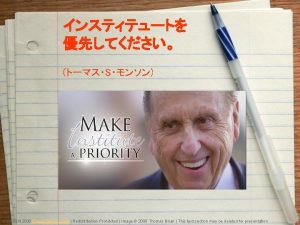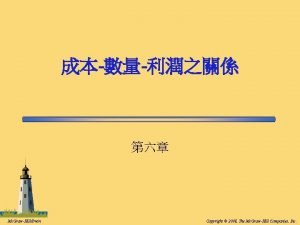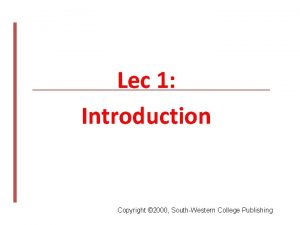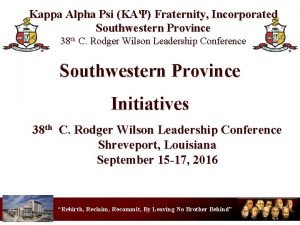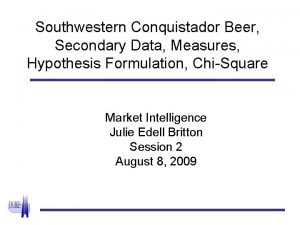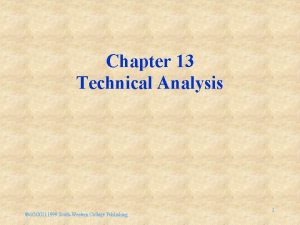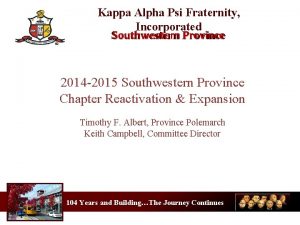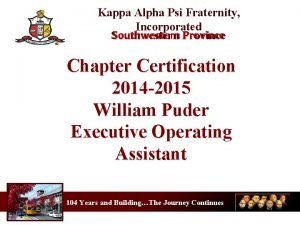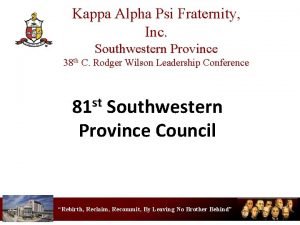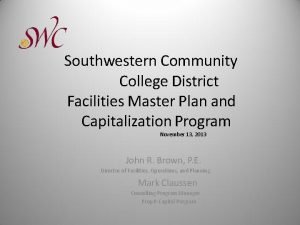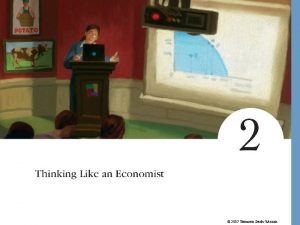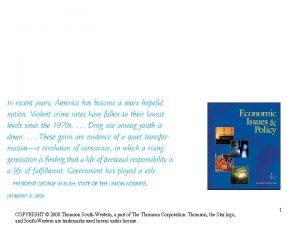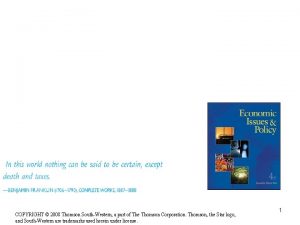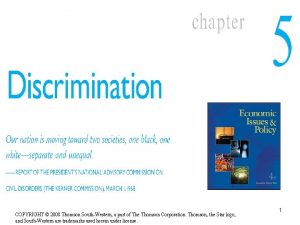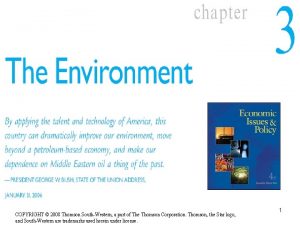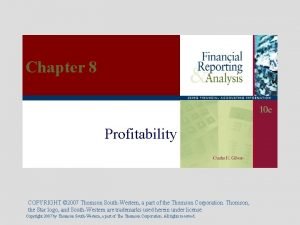COPYRIGHT 2008 Thomson SouthWestern a part of The



























- Slides: 27

COPYRIGHT © 2008 Thomson South-Western, a part of The Thomson Corporation. Thomson, the Star logo, and South-Western are trademarks used herein under license. 1

Competition • • Market structure in which seller cannot influence price Protects consumers from potentially unreasonable prices and prohibits any supplier market power – Ability of individual firm to influence market price of its product • Competitive market has three characteristics: 1. Many small buyers and sellers 2. Standardized product 3. No barriers to entry or exit • Important implication of characteristics is that competitive firm will be a price taker 11 -2 2

Competition (cont. ) 11 -3 3

Monopoly • Market in which only one firm (monopolist) produces product with no close substitutes – Historical examples: • • • Long-distance phone service (AT&T) U. S. postal service Monopolist is not a price taker (firm unable to influence market price of its product) but a price maker (firm able to influence market price of its product) – Does not mean firm will simply set highest possible price; firm can raise price by decreasing quantity it supplies • Characteristics of monopolies: 1. Single firm 2. Offers for sale a unique product with no close substitutes 3. Market has strong barriers to entry 11 -4 4

Monopoly (cont. ) 11 -5 5

Oligopoly • Market in which only a few large firms dominate (oligopolists) – Examples: • Automobile companies • Ready-to-eat cereal companies • Produce large enough share of total market supply of product so that each of these large firms can influence market price • If oligopoly firms agree to get together and cooperate on output levels, they can set price as high as if they were a monopoly 11 -6 6

Concentration Ratio • Percentage of output produced by four largest firms in an industry – If four or fewer firms, concentration ratio will be 100 – If industry contains many small firms, concentration ratio will be very low • • Many economists consider concentration ratio above 60 to indicate tight oligopoly in which firms have significant market power Although concentration ratios are useful indicators of possible market power, they are not perfect measures of market power 1. Concentration ratios based only on domestic (U. S. ) production and exclude foreign competition 2. Many markets are regional 11 -7 7

Concentration Ratios for Selected Manufacturing Industries 11 -8 8

Barriers to Entry • • Market characteristic that prevents new firms from entering market Seven common barriers to entry: 1. Economies of scale • • 2. Large amount of product can be produced at lower cost per unit than small amount of product Arise from technology used in manufacturing product, as well as organization of labor and any discounts that producer may receive on large purchases of inputs Exclusive franchises • • Permission by government (often local government) for monopoly firm to exist Often case when there is a natural monopoly – – Market with significant economies of scale Examples: » Local telephone companies » Natural gas companies » Electric companies 11 -9 9

Barriers to Entry (cont. ) • Seven common barriers to entry (cont. ): 3. Control of essential raw materials 4. Patents • • Legal protections that allow inventor to be sole provider of product for period of time Government gives patents for new products and new processes to encourage innovation and invention – Although patents encourage invention, also encourage development of market power: 1. Holder of patent will be sole producer of product for many years 2. Patents can be misused 3. Common practice of aggressively defending patents with patent infringement lawsuits discourages would-be competitors from producing close substitutes 11 -10 10

Barriers to Entry (cont. ) • Seven common barriers to entry (cont. ): 5. Product differentiation • Creation of image that one firm’s product is different from or somehow superior to other similar products – May be real (style, quality, or color) or artificial (created solely by advertising) 6. Licensing • Government requires new entrants to obtain license (permit) before beginning operation in many professions and trades 7. Behavior of established firms • Price-cutting is example 11 -11 11

Competition vs. Monopoly 11 -12 12

Collusion • Better known as price-fixing • Occurs when firms cooperate to restrict total market output and thereby obtain higher price • More likely in markets with relatively few firms and substantial entry barriers 11 -13 13

Types of Collusion • Cartel agreements – Group of producers that has explicit agreement to limit output and charge price higher than competitive price • Examples: – – • Organization of Petroleum Exporting Countries (OPEC) De. Beers diamond company Price leadership – – – Charging different groups of buyers different prices Occurs in markets in which firms never explicitly agree to collude, but instead somehow come to realization that it is in their best interests to charge similar prices and to restrict output to maintain higher prices One firm emerges as price leader and other firms adjust price whenever leader changes its price 11 -14 14

Inefficiency • Firms in concentrated markets tend to have less incentive to be efficient than do firms in competitive markets – Competitive firm must minimize cost of product in order to survive, but firm in concentrated market protected by entry barriers has no such incentive 11 -15 15

Price Discrimination • Charging different groups of buyers different prices when price differentials are not justified by differences in costs • Only possible when firms have significant pricemaking power • Extremely common in United States • Examples: – Automobile companies charging different prices for different models of cars – Drug industry charging different prices for drugs consumed by hospital patients rather than by retail buyers 11 -16 16

Forces That Decrease Market Power • • Technological change Antitrust activity Deregulation of unwisely regulated sectors Import competition 11 -17 17

Technological Change • Economies of scale often eroded by forces of technological changes • Examples: – Phone industry – Railroads 11 -18 18

The U. S. Antitrust System • Set of weapons designed to combat market power • Consists of laws passed by Congress, agencies empowered to administer laws, and court system to try cases under laws • Examples of federal antitrust laws: – Sherman Act (1890) – Clayton Act (1914) – Celler-Kefauver Act (1950) • Principal agencies charged with administering law are Antitrust Division of Justice Department and Federal Trade Commission (FTC) • Examples of antitrust cases: – – Ticketmaster (1993) Mc. Donnell Douglas and Boeing (1997) Sprint and World. Com (2000) Microsoft (2000) 11 -19 19

Regulation and Deregulation • Natural monopolies that exhibit substantial economies of scale are generally regulated by state or federal government agencies • Regulation involves limitation of market entry by granting exclusive franchises to firms – Natural monopoly is regulated with respect to rates charged and level of service offered • Major problem with regulation occurs when public utilitytype of regulation is imposed on industries that are not natural monopolies because they do not have substantial economies of scale – Regulation shelters firms from competition and actually causes inefficiency • Deregulation simply means lessening regulatory restrictions 11 -20 20

Import Competition • Import quotas and tariffs that limit competition from foreign imports are often called upon to protect American firms – Powerful firms that lobby Congress to limit imports are often in concentrated markets • Restricting imports protects market power in concentrated industries, but does not benefit American worker or consumers – By protecting market power in concentrated industries, ultimately cause lower output levels, lower employment, and higher prices to consumers 11 -21 21

Wal-Mart • World’s largest privately owned company, employing 1. 7 million workers and earning profits of $11. 2 billion in 2005 • Center of controversy as critics charge that its business practices are unethical – Among these charges are that: • It does not pay employees a living wage • It does not allow workers to form unions • It does not provide adequate health care insurance for employees • It discriminates by failing to promote women to management positions 11 -22 22

Wal-Mart (cont. ) • Effect on local communities is controversial – Critics argue that prices charged by Wal-Mart will drive local establishments out of business, and that lower prices may disappear when local businesses fail and Wal-Mart utilizes enhanced market power – Others argue that Wal-Mart enhances competition, thereby bringing lower prices to consumers – Also maintain that increased traffic resulting from large numbers of Wal-Mart shoppers visiting local communities will actually increase business of downtown merchants 11 -23 23

International Aspects of Market Power 11 -24 24

The Economic Left and the Economic Right • THE ECONOMIC LEFT (Liberal) – Believe competition creates efficiency, and government must act to reduce market power that impedes competition – Support antitrust policy and government regulatory authority – Feel antitrust system is needed to control excessive market power and that proposed mergers should be scrutinized closely before allowed to take place – Believe public utilities should be regulated to protect consumer from monopolistic excesses • THE ECONOMIC RIGHT (Conservative) – Feel market power is seldom serious problem – Believe barriers to entry are seldom so high as to eliminate threat of competition from new firms entering industry – Believe technological change erodes established monopoly positions – Seldom see need for antitrust or economic regulation, and believe such policies create inefficiency – Argue that any increased market power created when firms merge is controlled by potential competition from new entrants into industry and by technological change – Argue that government actually creates monopoly power by granting utility companies exclusive franchises 11 -25 25

Appendix: Elasticity and Monopoly Profits • Since monopolist supplies unique product, likely that demand for product is inelastic – When demand is inelastic, consumers do not alter quantities they purchase very much when price of product changes • Monopolists take advantage of situation by recognizing that even small reduction in quantity supplied will be associated with much higher price – Monopolist can increase profits by restricting output 11 -26 26

Appendix: Elasticity and Price Discrimination • Two different groups of consumers of longdistance phone service: – One group of businesspeople must phone clients during business hours and have few alternatives to making phone calls • Inelastic demand – Supplier can increase revenue by raising price – One group of nonbusiness consumers can use e-mail and make calls during the evenings or weekends • Elastic demand – Supplier can increase revenue by reducing price 11 -27 27
 Thomson southwestern
Thomson southwestern 2008 2008
2008 2008 Copyright 2008
Copyright 2008 Copyright 2008
Copyright 2008 Copyright 2008
Copyright 2008 Copyright 2008
Copyright 2008 Copyright 2008
Copyright 2008 Copyright 2008
Copyright 2008 2008 pearson prentice hall inc
2008 pearson prentice hall inc Southwestern college publishing
Southwestern college publishing Kreiger eye institute
Kreiger eye institute Kappa alpha psi southwestern province
Kappa alpha psi southwestern province Southwestern conquistador beer case solution
Southwestern conquistador beer case solution South western college publishing
South western college publishing Keonte turner
Keonte turner Catherine carpenter southwestern
Catherine carpenter southwestern Kappa alpha psi moratorium
Kappa alpha psi moratorium Kappa alpha psi southwestern province
Kappa alpha psi southwestern province Southwestern college publishing
Southwestern college publishing Southwestern province
Southwestern province Kappa alpha psi southwestern province
Kappa alpha psi southwestern province Southwestern community college
Southwestern community college Symplicity rutgers law
Symplicity rutgers law Southwestern college cincinnati ohio
Southwestern college cincinnati ohio Southwestern educational publishing
Southwestern educational publishing Gấu đi như thế nào
Gấu đi như thế nào Môn thể thao bắt đầu bằng chữ f
Môn thể thao bắt đầu bằng chữ f Khi nào hổ mẹ dạy hổ con săn mồi
Khi nào hổ mẹ dạy hổ con săn mồi






